[disclose]
Taipei is an underrated tourist destination. It often gets overlooked compared to other Asian cities like Tokyo, Hong Kong or Bangkok. We’ve been known to do quick side trips from Hong Kong (thanks to 4,500 point Avios redemption each way for Cathay Pacific flights) to just eat for the weekend.
Jinna Wang, author of Mini Budget Manhattan and the website Bicoastal Cooks, share her tips for Taipei.
If you would like to write about your recent travel experiences on The Flight Deal, submit your pitch here.
====
Taipei is Taiwan’s largest city and a popular tourism destination for its many night markets, hot springs, and hiking trails. This laid-back capital city is a city of contrast: hipster coffee shops dot the same streets that host traditional markets; tea plantations are only a quick train ride away from the stunning Taipei 101 tower.
Taipei is a city that truly has something for everyone. Here are some practical travel tips to make your visit as smooth as possible.
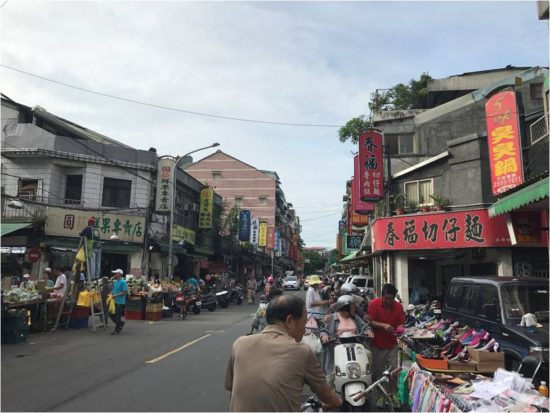
A traditional morning market in Taipei – Photo: (c) 2017 – Jinna Wang of Bicoastal Cooks
Weather
This was the most unexpected part of our trip. Although we had checked the weather reports ahead of time, it’s hard to conceptualize what 85 degrees and 100% humidity means until you are right in the thick of it. Picture sweaty people in damp t-shirts walking down the street carrying mini battery-powered fans.
It rained sideways every day that we were there. If you are visiting during the summer months, rain is to be expected. Convenience stores sell cheap umbrellas for ~NT$100, but I recommend bringing your own sturdier version to combat the strong winds.
Currency and Payment
The Taiwanese currency is the Taiwan dollar, which is trading at approximately 1 US dollar to 30.5 Taiwan dollar (NT$). To make mental calculations easy, I usually take the quoted NT$ amount, shift the decimal point to the left by one place, and divide by three.
A currency exchange is available at Taoyuan airport, and many ATMs operate throughout the city.
One thing to note, Taipei, for all its modernity, is still largely dependent on cash. Try to budget enough cash to cover all your spending for the entire trip, since it is difficult to rely on credit cards. For our four day stay, we only found three places that accepted credit cards: Family Mart, Watsons, and a museum gift shop. Even fairly large restaurants, hostels, and some convenience stores were cash-only. Night markets, roadside shops, and even the kiosk for purchasing the Easy Card were all cash only.
Connectivity
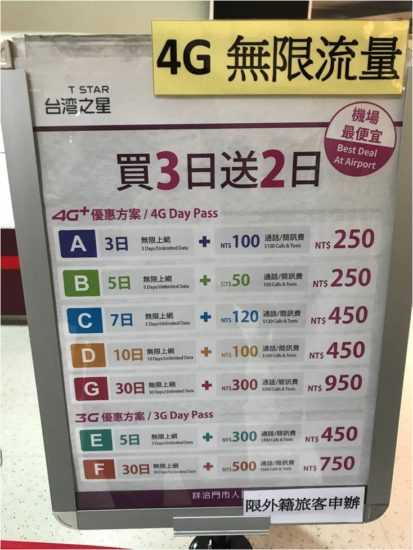
Data plans offered at Taoyuan airport – Photo: (c) 2017 – Jinna Wang of Bicoastal Cooks
4G and 3G data plans are available at airport kiosks (they weren’t open when we landed at 5am). NT$250 will buy a five day unlimited data plan plus NT$50 call and text credit.
Another option is to get a portable wifi hotspot (mifi). You can order these ahead of time online and pick them up at the airport. The cheapest plan costs $3 USD per day, and can be shared with up to five devices.
Transportation
From Taoyuan airport, you can take the Taoyuan Airport MRT into the city. The Taipei metro, more popularly called the MRT (Mass Rapid Transit), lives up to its name. It is fast, clean, and affordable. A TV screen displays the estimated time until the next train and it is amazingly accurate.
The best way to use the MRT is through the EasyCard. Similar to the Octopus Card in Hong Kong, the EasyCard is a touch-and-go system that lets you access the MRT, buses, public YouBike bicycle rental, and pay for small items at convenience stores such as 7-11 and FamilyMart.
The EasyCard costs NT$100 as a deposit, and can be reloaded at any MRT station. You can go down to a negative NT$60 balance on the card, but it must be reloaded before you can use it again.
Food
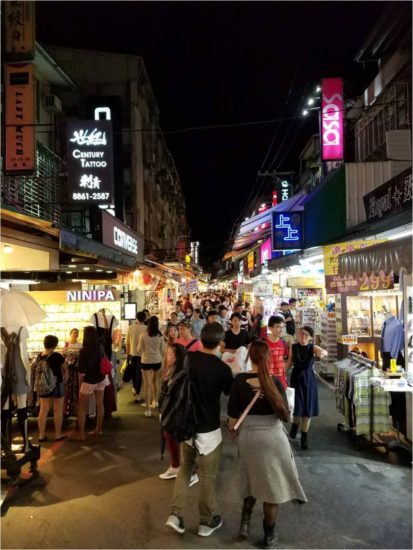
Shilin night market – Photo: (c) 2017 – Jinna Wang of Bicoastal Cooks
Ah, food, my favorite part of any trip. The food options in Taipei are truly endless and fantastic. I would be remiss to not steer you toward the city’s night markets. The night markets are essentially outdoor hawker stands by individual proprietors, each offering up tasty morsels of their specialty wares. Popular night markets include Shilin, Raohe, and Tonghua. A dish usually costs anywhere from NT$40 to NT$100.
Here are a few things that you should try at night markets (these are sorted from “easy eating” to “for adventurous eaters only”):
- Steak cubes – marketed as “dice” steak for the small square pieces the meat is cut into
- Taiwanese fried chicken
- Lǔ ròu fàn– braised pork sauce over rice
- Black pepper buns – small flaky pastries stuffed with peppery pork
- Oyster omelets
- Small sausage in large sausage – kind of like a hotdog in a sticky rice bun
- Grilled octopus
- Ice cream crepe with peanut and cilantro
- Oyster vermicelli – thick, warm, and slimy
- Pork blood cake – congealed blood and rice cake on a stick, coated in a nutty powder
- Stinky tofu – you’ll find it, just follow the smell (the taste is surprisingly mild)
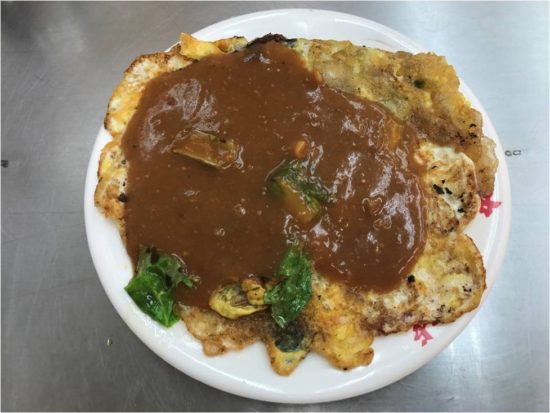
Oyster omelet at Shilin night market – Photo: (c) 2017 – Jinna Wang of Bicoastal Cooks
Aside from night markets, you should visit Lín dōng fāng for the famous braised beef noodles. Highly recommended by my friends who have visited, these noodles are amazingly flavorful and well worth the wait, which could be up to an hour outdoors in the humid heat. Try to go in groups of two or less to get seated quickly.
Lastly, don’t leave Taipei without trying a few Taiwanese breakfast specialties. Fresh soy milk, fresh rice/peanut drink, Yóu tiáo (fried crullers), and steamed soup dumplings are all delicious options. Breakfast for two at small roadside stalls should cost NT$150-200.
Activities
The mountainous nature of Taipei offers an abundance of hiking trails for outdoor enthusiasts. A popular hike is the Elephant mountain hiking trail. Elephant mountain is easily accessible by the red line on the MRT. The easy 20-min hike leads to a few viewing platforms to see Taipei 101.
If you prefer your outdoors with more relaxation than exercise, you can take the MRT to New Beitou Station for the hot springs. We opted for the public hot springs, which, at 10am on a weekday, were packed with local seniors who all seem to be regulars. For men, make sure to bring a bathing suit with no pockets, otherwise you will not be allowed in the water. The hot spring management sells bathing suits onsite for people with the wrong type of bathing suit. To avoid the crowd at the public hot spring, you can book one of the local hotels that offer private hot spring experiences.
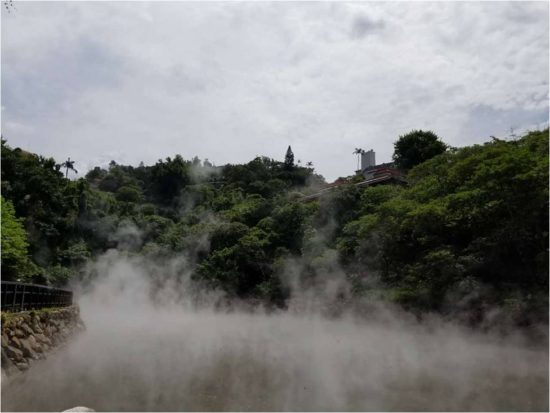
Thermal Valley in Beitou, Taipei – Photo: (c) 2017 – Jinna Wang of Bicoastal Cooks
Just a quick 10-min walk from the public hot springs is Thermal Valley, one of only two green sulfur springs in the world (the other is in Akita, Japan). This is not a spring for bathing – the water is boiling hot and smells strongly of sulfur. But the steam-filled valley with its jade green waters makes a great photo op.
If you prefer urban shopping to nature exploration, definitely visit Xī mén ding. This area of the city has been called the Harajuku of Taipei, and offers a plethora of shopping, restaurants, coffee shops, and bars. The infamous Modern Toilet restaurant, where food is served in miniature tubs, sinks, urinals, and toilets is located here. There is also a large three-story Watsons here for all your beauty and personal care needs.
Lastly, my favorite find is an area called Legacy Taipei, about a 20-min walk from Lín dōng fāng beef noodles. Built as a concert arena, this pedestrian-friendly area has a number of artisanal shops selling jewelry, soap, beer, and more. My pick is an adorable store that sells wooden puzzles and knickknacks, which also has a play area that educates people about Taiwan’s lumber industry. You can learn about the different trees that grow in Taiwan and play with toys made from the wood that corresponds to those trees. Try the four-piece wooden puzzles; they are harder to crack than you may think.
About The Author:
Jinna Wang is a freelance writer and translator living in New York. You can usually find her traveling, eating, and writing about both. Her first book, Mini Budget Manhattan, documents an experiment in which she fed herself for $50/month in New York. Find her at Bicoastal Cooks, and find more of her writing here.
=====
To make sure you receive our latest deals, LIKE our The Flight Deal Facebook Page, follow us on Twitter @TheFlightDeal, Threads @TheFlightDeal or The Flight Deal WhatsApp channel or subscribe to The Flight Deal RSS Feed or Subscribe via Email (Once a Day)
The Flight Deal does not sell travel products or services. We provide you with information about third-party travel suppliers’ offers, and link you to their sites. The information posted by The Flight Deal is valid at the time of publication. However, we have no control over the suppliers, and we therefore do not warrant or guarantee that their offers will not change or become unavailable. Nor are we responsible for their products, services or site content. Please see their sites for their most up-to-date offer information and all applicable terms and conditions.
Sign up to receive The Flight Deal Daily DealsLetter, to stay up to date with the latest and greatest flight deals available.

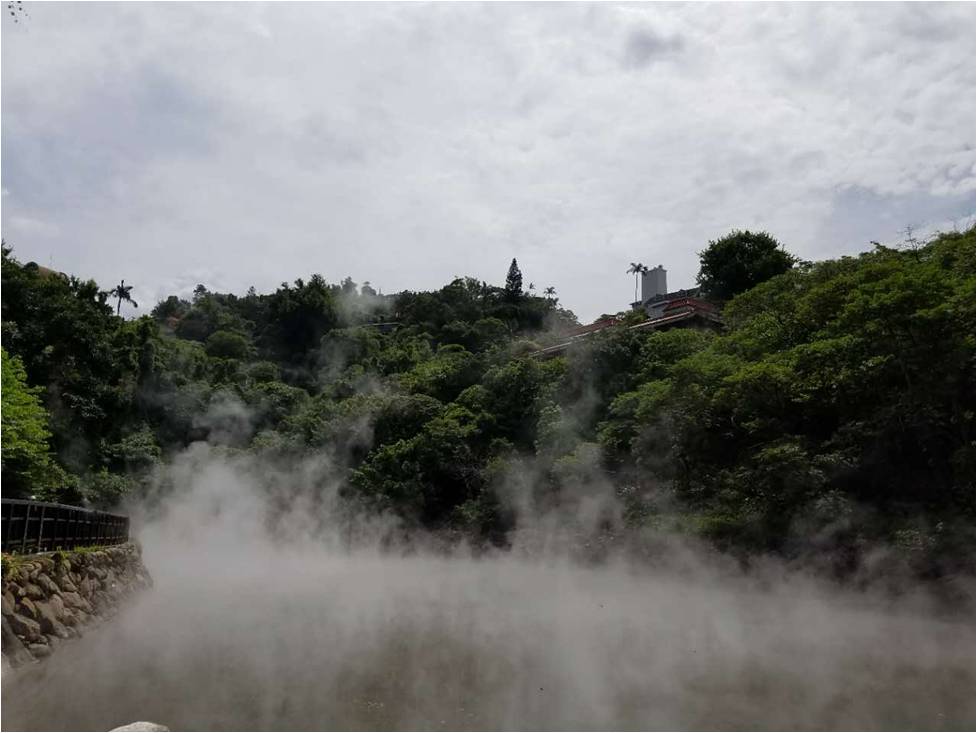
Awesome guide to Taipei, we definitely could have used this last year when we had a short trip to Taipei. Completely agree about the easy Avios redemption to get over from Hong Kong.
About the food, I was also really surprised hot pot was so popular in the humid and hot days there. I’d also recommend soup dumplings as we had the obligatory visit to Din Tai Fung.
There also seemed to be big outdoors community with hikes and water tracing. I wrote about some of it in my trip report from last year. http://travel2walk.com/2016/09/14/trip-report-long-weekend-in-hong-kong-and-taiwan-with-dad/#taiwan
Thanks John! Hot pot (at least in my part of China) is popular during the summer months because people believe that eating hot/spicy foods helps you break a sweat and detox during the summer heat. Then we usually wrap up hotpot with some ice cream or other cold desserts 🙂
Jinna
Thanks for the info Jinna. I had known that about Sichuan and I guess it’s more appropriate in Taipei with the seemingly higher heat and humidity, at least from our few days there.
Great article! The Lin dong fang beef noodles were easily the best I have ever had